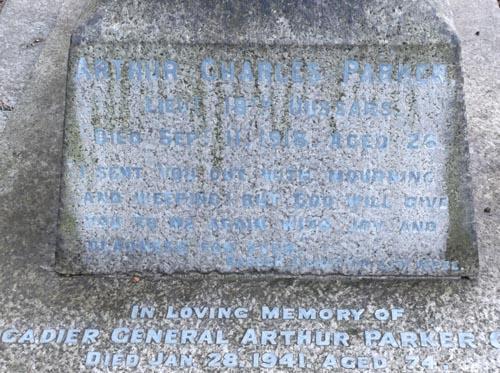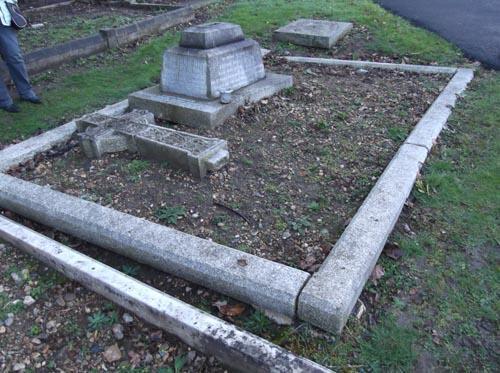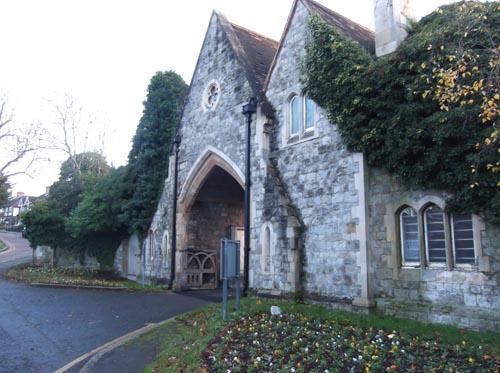Biography of Lieutenant Arthur Charles Parker
18th (Queen Mary’s Own) Hussars
Died 11th September 1918
Soldier
- Name: Arthur Charles Parker
- Date of birth: 2nd July 1892
- Place of Birth: Chakrata, Uttaranchal,
- India
- Date of Birth Registration: Unknown
- Place of Birth Registration: Unknown
- Name: Arthur Parker
- DOB: 14th January 1867
- Place of Birth: Grantham, Lincolnshire, England
- Occupation: Major 5th Lancers (Active list)
- Name: Eleanor Augusta Hilton
- DOB: 6th April 1863
- Place Of Birth: Uxbridge, Middlesex, England
- Marriage: 10th September 1891 Uxbridge, Middlesex, England
- Arthur Charles Parker, 1892, Chakrata, Uttaranchal, India
- Josephine Mildred Parker, 1892, Chakrata, Uttaranchal, India
Census
- 1901: Arthur is living with his grandparents Charles and Martha Parker at Stone Bridge House, Harrowby, Grantham, Lincolnshire.
- 1911: Arthur is living with his parents at 18 Belmont Terrace, Circular Road North (Glasnevin, Dublin). The census gives him an age of 18 and he is listed as being at school.
- Arthur’s cousin Rupert Hardy Parker also fought and was killed in WW1. Rupert can be found on our page dedicated to the Morton War Memorial.
- No marriage for Arthur has been found and because of his age we can assume that he never had the opportunity to marry.
- Arthur Charles Parker was the Gt-Grandson of Lt-Col William Parker of Hanthorpe House, Hanthorpe, Lincolnshire. William was Deputy Lieutenant of Lincolnshire and appointed High Sheriff of Lincolnshire in 1864.
Newspaper Mentions
- Uxbridge & W. Drayton Friday 13th September 1918
PARKER – On September 11th, at Queen Alexandra’s Military Hospital, London, Lieutenant Arthur Charles Parker, Tank Corps. only son of Brigadier General Parker and grandson of the late Rev. A. D. Hilton, Vicar of St. John’s, Uxbridge Moor, aged 26 years.
- Uxbridge & W. Drayton Gazette Friday 20th September 1918
FUNERAL OF THE LATE LIEUTENANT PARKER
On Saturday afternoon the funeral took place of the late Lieutenant Arthur Charles Parker son of Brigadier General A Parker and grandson of the late Rev. A. D. Hilton. Deceased, who was only twenty six years old, was a handsome promising young soldier, but the strain of the war told upon his constitution, and he came on leave in a sadly run down condition. Failing to regain strength, he went into hospital and eventually pneumonia set in and was the immediate cause of death. His regiment was the 18th Hussars but had been attached to the Tank Corps. The funeral took place at Hillingdon Cemetery, the Rev. R.M Carrick officiating and the choir of St. John’s, Uxbridge Moor was in attendance. The mourners were Brigadier General Parker (father), Miss Hilton, Miss A. Hilton, Mis M. Parker, Captain Parker, Major and Mrs. Dewar-Harrison, Mr and Mrs Wise and Colonel Cape (5th Lancers).. Amongst the floral tributes was a beautiful wreath from the officers of the 5th Lancers
Military Records
- None found
- These records show that Lieutenant Arthur Charles Parker, Royal Tank Corps (11th Hussars) was killed in action on 11th September 1918 in London
- None found
Effects Left To
- By probate to father Arthur
Medals
- The British Medal
- The Victory Medal
Memorials
- UK:
- Morton, Roll of Honour in St John the Baptist Church
- Hillingdon and Uxbridge Cemetery buried in a family grave
- Commonwealth War Graves Commission:
- In memory of Lieutenant Arthur Charles Parker, 18th (Queen Mary’s Own) Hussars Regiment who died on 11 September 1918
- Son of Brig. Gen. A. Parker, of Love Hill, Langley, Bucks.
- Remembered with honour, Hillingdon and Uxbridge Cemetery
- Grave I. 4 & 5

© Picture taken by South Lincolnshire War Memorials

© Picture taken by South Lincolnshire War Memorials

© Picture taken by South Lincolnshire War Memorials
- We are unable to trace Arthur Charles Parker through his WW1 service records or Pension records as these are not listed. It is highly likely that these are part of the burnt records.
- From the CWGC records we know that Lieutenant Arthur Charles Parker was of the 18th (Queen Mary’s Own) Royal Hussars. A very useful book, The Memoirs of the 18th (Queen Mary’s Own) Royal Hussars, 1906 -1922, has proved the best source for any information that can be found about Arthur Charles Parker.
-
The following has been compiled from the information in this book.
2nd lieutenant A C Parker, S.R. (Service Reserve) Joined the regiment on 18th June 1916
He fought with the 18th Queen Mary’s Own Royal Hussars from arriving in France in June 1916 up until he was wounded on 2nd July 1917. The list of officers wounded does not show if we was shipped back to England but his name does not appear in the memoirs after July 1917 and so this is the assumption.
From the list of officers compiled for the regiment Arthur Charles Parker appeared on the 1917 list as; 2nd lieutenant Parker A C, (S.R) and again in 1918, after he was wounded as, 2nd lieutenant Parker A C (Reserve Cavalry).
The following brief outline of the Regiment from June 1916 to July 1917, Arthur’s time with them, has been taken from the book.
1916
On June 7th the Regiment sent a message of sympathy to 1916 the Royal Navy on the loss of H.M.S. Queen Mary. Capt. Prowse, who commanded the ship, had written to Colonel Burnett during the winter of 1914, cheering the Regiment on and saying he wished that they in the Navy could help it more. The Captain of the Queen Mary and the Officer Commanding the 18th Queen Mary’s Own Hussars had often corresponded, and it was their great desire to get the ship and the Regiment in touch with one another, as they hoped to do during some friendly reunion in peace time.
On June 24th the 1st Cavalry Division began its move from billeting area to concentration areas and thence to assembly areas, in accordance with the scheme for employing cavalry, after the ” break through ” on the Some had been accomplished, to seize Bapaume and the high ground in its vicinity.
The 1st Cavalry Division was to operate as left flank guard to the 2nd Indian Cavalry Division, which was to seize Bapaume with a right flank pushed out to the neighbourhood of Beulencourt, in touch with our troops, or the French, to the south. The 1st Cavalry Division was to seize Irles and the high ground to the east of that town.
Accordingly on June 24th the Regiment left Alette and marched via Leboisie-Outre Bois-Bertencourt-Les Dames to Querrieu, and bivouacked there till July 5th, when it moved one march to Avelesges, but was back again at Querrieu on July 11th.
On July 13th the Regiment moved to Buire, and on the 24th back once more to Querrieu, bivouacking for the most part in Querrieu Wood, and furnishing during this period ” digging parties ” for various parts of the neighbouring line of trenches.
During June, one Hotchkiss gun per troop was issued to the Regiment, This compensated for the loss of the machine guns, which had been taken away in February, when the M.G. Corps was formed.
The Regiment remained at Querrieu till August 5th, and then moved via Pont Remy to Longroy. On July 12th an alteration had occurred in the scheme which the cavalry was to follow, should a ” break through ” occur
The objectves of the 1st Cavalry Division being altered to Leuze Woody Bouleux Woody Morval and Les Boeuf, The 1st Cavalry Division was to move forward behind the 2nd Indian Cavalry Division, This move depended on the success of the 4th Army in capturing the enemy’s second line between Longueval and Bazentin-le-Petit’ and the period closed on July 23rd.
During September the scheme was again changed: this time the 1st Cavalry Division was to seize the high ground – Rocquigny, Villers au Flosy Riencourt’ Bapaumey when the infantry had captured Flersy Gueudcourty Les Boeuf and Morval. – The 2nd Cavalry Brigade was to move on Barastre as soon as the 1st Cavalry Brigade had attacked Rocquigny. This period ended on September 17th.
For these “break throughs ” the cavalry adopted what was termed ”Gap Organisationy” which meant mobility to the nth power, and hence a good deal of discomfort.
On September 6th and 7th the Regiment marched to La Neuville and bivouacked in the Carnoy Valley, where it was to be ready to operate on the right flank of the 4th and Reserve Armies, which were attacking towards Sapinesy Achiet le Grand and Miraucourt. Final success did not however attend our army and on September 17th the Regiment moved back to Vied Hesdin via Amiensy Bouchon and Fillievres’ and then went into billets at Pernois to wait there till November 8th in daily expectation of a chance to break through. This time the effort was to be made in co-operation with the 3rd Corps of the 4th Army which was to develop an attack on the Butte de Warlencourt. The 1st Cavalry Division was to follow up a successful attack by establishing itself on the high ground between Bois Loupert and Achiet le Petit ; but operations were postponed from day to day on account of the weather which was very bad. Finally the attack was fixed for November 10th but on November 7th the order was cancelled, and the cavalry marched into winter billets.
The Regiment moved in consequence to billets at Bernieulles marching via Le Titre and Abbeville, ” A ” Squadron was at Racquesy “B” at Beussent and “C” at Inxent.
During the winter, which was very severe with much wet, severe frosts and a good deal of snow and fog, the Regiment formed a Pioneer Battalion of 8 Officers and 230 other ranks, under command of Major C. J. Thackwell, D.S.O., for trench work in the neighbourhood of Tincques.
Uneventful days were spent in billets near Bernieulles until the attack on the Vimy Ridge which took place at the beginning of April, 1917.
1917
For the Vimy Ridge operation the 1st Cavalry Division was attached to G.H.Q. Reserve. ” Gap ” organisation was adopted on April 4th, and the Regiment left its billets on April 5th and, marching via Fruges, Croix and Lemet, arrived at Athies on April 10th,the day Vimy Ridge was assaulted and captured by the 1st Army and Canadian Corps.
Three Officers and 93 other ranks were detached on April 5th to form part of a dismounted battalion of 18 Officers and 600 other ranks, under Major Thackwell, which was to join the 4th Canadian Division.The idea was that the 1st Cavalry Brigade was to operate north of the River Scarpe in front of the 4th Division, while the remainder of the 1st Cavalry Division supported the 1st Cavalry Brigade.
On April 10th the Division moved at 1.30 p.m. to Anzin, and at 4 p.m. the Division was to move forward ; but the 1st Cavalry Brigade made no progress, and on the night of 10th-11th April the situation was as follows : 1st Cavalry Brigade H.Q. at Athies, with one regiment between Athies and Farnpous, two regiments at Fampous ; 2nd Cavalry Brigade just east of Athies ; Divisional H.Q. east of St. Nicolas.
On the 11th the Infantry were again to attack along the line Wancourt – Guemappes – Monchy – Pelves – Mount Pleasant Wood, and the cavalry were to take advantage of any successful attack; but the 4th Division made no progress, and on the 12th the cavalry were withdrawn.
The weather, as everyone will well remember, was vile, very cold winds, heavy snowstorms and much mud, and to these elements men and horses were exposed all day and all night in the open for forty-eight hours. During these operations the Regiment lost : Privates Provis and Annakin, killed in action, and Pte. McGeoghegan, died of wounds, and two men wounded.
On April 17th the 2nd Cavalry Brigade moved to the area about Fressin. The Regiment had its Headquarters and ” A ” Squadron at that village, ” B ” at Wambercourt and ” C ” at Sains.
The strength at this period was 33 Officers, 587 other ranks and 541 horses.
The Regiment remained at Fressin until May 13th endeavouring to get the horses back again into condition, as they had suffered greatly from exposure during the Vimy Ridge operations.
On May 13th the Regiment marched to Calonne-sur-La Lys, arriving there on the 15th via Matringhem and Les Presses
It remained at Calonne till August 27th. The Division was at first attached to the 1st Army, and pioneer battalions were formed. They proceeded to the neighbourhood of Rochincourt and were attached to the 5th Division of the 13th Corps. The 2nd Cavalry Brigade formed the 2nd Pioneer Battalion, which marched to Robecq for duty in the trenches near the village of Bailleul, just left of the Vimy-Revin Railway, and near Lens. The working party at Lens had a difficult task, working continually and digging under fire. Lieutenants. Beevor and Parker were wounded and Corporal Malcolm, Lance Corporal Smith, Privates Aitken, Bowman, Clarke and Garbut were killed on June 21st, and Trooper Bedford and Private Hardy were killed on July 1st ; in addition, 17 other ranks were wounded during these trench-digging operations.
The wounded officers list shows the Lieutenant Beevor was shipped back to England but here is no mention of the movements of Lieutenant Arthur Charles Parker from the moment he was listed as wounded.
We can only assume that it was this action that placed Arthur Charles Parker in the Millbank Millitary Hospital in September 1918 when he died.
Sources
- WW1 Soldier’s Records (www.ancestry.co.uk)
- British Newspaper Archive.
- Fold 3
- Find My Past
- Genealogist
- Forces War Records
- British Army Service Numbers
- War Gratuity Calculator
- Commonwealth War Graves Commission
- National Archives – Battalion War Diaries
- General Registry Office